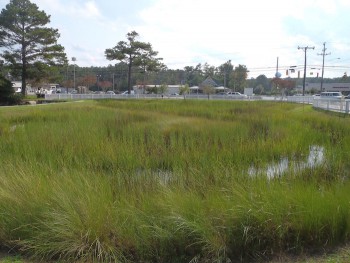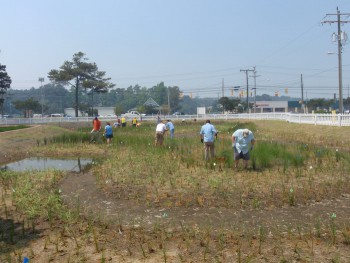For years, Shallowbag Bay has been deemed impaired by the U.S. EPA’s 303(d) water quality list and has been closed to shellfish harvest due to high bacterial levels. This was both a wake-up call and an opportunity for the Town of Manteo and other North Carolina organizations to do something about the problem. The town’s original stormwater system was designed to collect runoff and send it through outfalls emptying directly into Shallowbag Bay. Something had to be done to improve this system so that the stormwater runoff could be treated before entering the bay.
With the goal of restoring the impaired coastal waters the Town of Manteo, The North Carolina Coastal Federation, NC Department of Transportation, NC State University, NC Clean Water Management Trust Fund and the OuterBanks Visitor’s Bureau worked together to make a change. They purchased a shopping center located next to US Highway 64 in Manteo and replaced the paved lot and building with an innovative saltwater stormwater wetland park. Through the help of project partners and volunteers the wetland was planted with native marsh grasses which act to filter out runoff pollutants. The wetland redirected the original stormwater outfalls and captures stormwater runoff from nearby impervious surfaces, mixes the runoff with saltwater and runs the water through the purifying wetland all before emptying into Shallowbag Bay. This wetland park not only serves as a shining example of what can be done with collaborative efforts in attempt to recover impaired waters, but is also used as an education and public involvement tool.

The site today is a flourishing wetland with thriving native plants that provides effective stormwater management.
The wetland continues to operate successfully from a biological stand point, based on vegetation monitoring that staff has been tracking since its installation. The native plants have increased in average height and density over the years, thus increasing the wetland’s filtration capacity. Now with the continued help of Coastal Federation staff, the Town of Manteo and UNC’s Coastal Studies Institute, samples will be collected and analyzed to monitor the water quality of the wetland. The goal of this monitoring is to determine the effectiveness of the wetland in eliminating harmful bacteria, correlated with illness, from entering the bay. Monitoring is an important phase of this project to ensure the effectiveness of the wetland and to see if any improvements need to be made. These efforts will add to the existing knowledge of suitable stormwater management practices and will ease the process for future projects.

